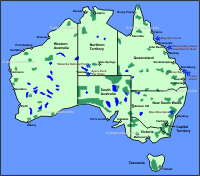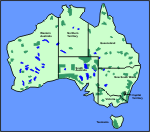 |
General Information about Australia

Before we start our trip through Australia we will talk a little about the geopraphy, the population and the history of the Australian continent. Moreover we will have a look at the population, its distribution in the country as also their religions.
The Geopraphy of the Australian Continent
With a surface of 7.692.030 square kilometres, Australia is the smallest continent of the world, but therefore the biggest island on earth. The continent is located in the southern hemisphere close to the equator. Due to this, the seasons are contrary to our seasons in Europe, which means that when it is summer in Europe, in Australia it is winter. Comparing it with European countries, Australia is 21 times bigger than Germany, 91 times bigger than Austria and 186 times bigger than Switzerland.
Compared to Germany, there are much bigger cities in Australia and much more unused surfaces as the famous outback of Australia. Australia is subdivided into 6 federal states as also in the island Tasmania that also belongs to the Australian continent.

The most Important and Fanous Citites of Australia are:
- Sydney (New South Wales)
- Melbourne (Victoria)
- Brisbane (Queensland)
- Adelaide (South Australia)
- Perth (West Australia)
- Canberra (Capital in the Australian Capital Territory)
- Darwin (Northern Territory)
- Alice Springs (Northern Territory)
- Hobart (Tasmania)
The famous eastern coast is the most densely inhabitated, where in the Australian summer time the most tourists are. The population in the upcountry is rather scant, as also in the north and the west of the country. Apparently, this is due to the extreme climate zones: these are in the upcountry with a very arid climate up to a tropical climate in the north as also in the north east of the country. But it is also possible to ski in Down under (the way the Australains call their country), as for example in the Snowy Mountains in Bew South Wales or at the Halls Gap in Victoria.
Australia is considered as the driest populated continent in earth; Except the Antarctic, there is no other continent that is more misanthropic. For the Australians, water restrictions are part of the daily life. Specially the huge metropolis Sydney has to bear up its daily water consume with the one of the inhabitants, a thing that currently led to a very controversal plan of a seawater-demineralization plant.
To the contrary, the flora and the fauna adapted to the dry climate. Every year, Australia has to struggle with the bushfires, a thing that is vital for the flora, as the seed vessels of all plants need the heat of a bushfire in order to be able to open at all in order to reproduce. For example, the famous eucalyptus trees belong to the very resistant kinds of plants.
The History of Australia
Approximately 400 years ago, the aborigines, who are considered to be the natives of Australia, were the first who settled down in the continent. The first Europeans arrived in the 17th century to the continent; up to the year 1770, nobody of them took the country for his crown in his possession.
But James Cook had a different opinion: with his arrival, he wanted to proclaim for his home country Great Britain. The so-called "First Fleet" with prisioners arrived at Australia in the year 1788. They were damned by the British Crown to Australia as the first population. In the year 1768, the command of the today famous Endeavour was assigend to James Cook. At that time, he was 40 years old and a British naval officer. James Cook was appreciated in whole Great Britain for his capability of navigating.
James Cook had a mission for the trip. He was supposed to observe the alleyway of the venus by the sun in Tahiti in order to find the much sought after south continent that would form the logical counterbalance of the landmass of the north. First, Cook spent more than a year in New Zealand until he departed on April 1st 1770 in western direction; approximately three weeks after he arrived at the east coast of Australia. He landed in Botany Bay, the Sydney of today. This is the official beginning of the history of the fifth continent. From that time, the history of the country is as per the following chronology:
- 1788 The first fleet of prisioners "First Fleet" from England arrived to Australia in order to populate the country.
- 1793 The first free inhabitants arrived.
- 1851 Beginning of the des Gold Rush in Victoria and New South Wales
- 1860 The first north-south crossing of the continent accomplished by two Europeans takes place. But on the way back from the Gulf of Carpentaria to Melbourne, Burke and Wills lost their lifes.
- 1901 Australia is declared to a "Federal Commonwealth of Australia" and therewith to an independent state.
- 1915 Australia fights during the first world war at the side of Great britain. But a battle in the turkish Gallipoli became an inevitable fate for the Australian-New Zealand troups. Still today, the high numbers of the killed soldiers are memorized in the national bank holiday ANZAC-DAY.
- 1927 Canberra is declared to the definite seat of government of Australia.
- 1929 For the first time, a railway stretch communicates (the Ghan) Adelaide and Alice Springs in the centre of the country.
- 1931 Australia joins to the Commonwealth of Nations.
- 1942 During the second world war, Japanese troups attack Darwin. As it was the case in the first world war, Australia was again at the side of Great Britain.
- 1950 up to 1970 There are high immigration waves, specially from Asians, a until then they were not allowed to get into the country.
- 1956 The Olympic Games took place in Melbourne.
- 1960 The aborigines become officially Australian citizens.
- 1966 The Australian dollar is introduced.
- 1994 The greater area of Sydney is devastated by a grave bushfire.
- 1999 There is a popular vote for the conservation of the British monarchy (decision in favour of the monarchy)
- 2000 The Olympic games take place in Sydney.
- 2002/03 Major parts of Canberra are devastated by grave bushfires.
- 2004 The railway line (Ghan) is expanded up to Darwin.
- 2005 Some heavy race riots in Sydney convulse the image of a peaceful Australia.
The Population and Colonization of Australia
With 21 million inhabitants, Australia is, after the Antarctis, the continent with the less population. Different than other continents, Australia is mostly sparsely populated, very ample and everybody is your "mate", your so-called chap, as the Australians say. The following table provides an overview about the approximate density of the population in each of the federal states of Australia.
| Federal State |
Inhabitants |
Surface [km²] |
Inhabitants/km² |
| New South Wales |
6.500.000 |
800.000 |
8,1 |
| Victoria |
4.700.000 |
227.000 |
20,7 |
| Queensland |
3.500.000 |
1.730.000 |
2,1 |
| Western Australia |
1.850.000 |
2.530.000 |
0,7 |
| South Australia |
1.500.000 |
983.000 |
1,5 |
| Tasmania |
500.000 |
68.000 |
7,3 |
| Australian Capital Territory |
350.000 |
2.400 |
145,8 |
| Northern Territory |
190.000 |
1.300.000 |
0,1 |
The population of Australia is quite recent , but at that time when the white people started to populate Australia, the unity among the people was important for surviving. It is approximately 200 years ago when the first settlers came to Australia. The major part of the settlers were British, but also Americans, Chinese and Continental-Europeans (thereunder a lot of germans), settled in.
Australia was first populated alongside the coast; When the first populations took place, they growed to grand metropolis that are still today marked by its rapid growth. Due to the extreme dryness, the deep upcountry is very sparsely populated. Many Asian poeple were attracted by many Australian metropolis, a thing that today provides these cities a relaxed multicultural flair.

But the Australian natives, called aboriginis, were pushes away from their ancestral living spaces, their culture was stolen and many of them were killed thereby. Specially in south Australia, Victoria and New South Wales the natives were pushed away, in Tasmania even exterminated, as these areas were very popular for the white settlers.
In the north of West-Australia, the Northern Territory, or in Cape York, many tribes of the natives live far away from the white civilization in accordance to their culture. In the cities, the natives belong to the social bottom, but the matter of Australian natives is here rather unconsidered.
In Australia, 92% of the population is of European origin, 7% of Asian origin; 2,4% are of indigenous origin. 15 % of the white population are not of British or Irish origin. Approximately 800.000 persons belong to ex-Yugoslavia, approximately 600.000 each to Greece and to Italy. With approximately 200.000 inhabitants, the polish citizens rather form a separate minority in Australia.
More than 1,3 millions of Australians have at least one German ancestor. For approximately 79% of the inhabitants, English is the most spoken language, 2% speak Chinese or Italian. Specially in the sixties, the immigration of the Asian people got stronger due to the omission of the immigration regulation.
The population of the immigrants grew in the ninetees approximately 1,4% per year, a quarter of the population was not born in the country. The birth rate of Australia is of 1,8 children per woman. 92% of the population live in cities, mainly in the big centres at the south-east coast, in Tasmania and in the greater area of Perth. To the contrary, the centre of the country is deserted.
Different Regions of Australia
Approximately 70% of the Australains belong to one christian religious group, but the exact numerical values are controversial until now ; it is assumed that in the year 2001, more than 12 millions Australians admitted the christendom; Approximately 26% of the Australians admit to belong to the catholic denomination.
In Australia, there are also buddhist (approximately 400.000 persons), islamic (approximately 300.000 persons) as also Hindoo (approximately 100.000 persons) denominations are represented. More than 80.000 Australians form further denominations worth to mention. But there are also Australians who do not admit any religion at all, thereby, 3.000.000 persons are estimated. As one can see, also in the other end of the world many different denominations live peaceful together and with each other.

Back to the index Australia
Author: Simone Palm; Copyright: Patrick Wagner, www.tourist-guide.biz
|
 |